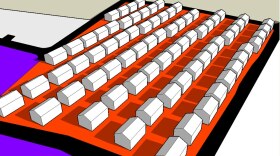It turns out, New Mexico’s story of a dearth of affordable housing and rents that just keep going up are mirrored around the country, but there is an exception – Albuquerque rents have risen more than many other cities. That’s according to the Harvard Joint Center for Housing Studies, which recently released its annual State of the Nation’s Housing report for 2022. The report’s lead author, Daniel McCue, talked to KUNM.
DANIEL MCCUE: The leading headline for us this year was the soaring costs of housing. House price appreciation hit 20%, a 30-year record in August of 2021, and kept going up from there hitting a new record in March and then again in April and still hovering around 20% growth in prices. That's really been widespread across the country. New Mexico is no exception to this. Albuquerque prices were up 21% over the past year, Santa Fe prices were up 22%. But we also saw rents were up too. Nationwide we saw apartment rents were up 12%, a 20-year high. In Albuquerque, we saw apartment rents were up even higher than the nationwide average at 18% year over year as of early 2022.
KUNM: Were there other striking differences or similarities?
MCCUE: You know the reasons behind these skyrocketing rents and prices were also kind of a nationwide phenomenon of a shortage of housing, a lack of housing, was something widespread in markets across the country. And that seems to be the case as well in New Mexico.
KUNM: What ways has the turbulent economy we've lived through over the last couple of years affected the state of housing?
MCCUE: The growing affordability challenges of housing made the situation much more tenuous for a lot of households – cost-burdened households who spend more than 30% of their incomes on housing, and those who are severely cost-burdened spending more than half their incomes on housing. We have over 37 million households in the country, about almost half of all renters are cost-burdened, and households that are cost-burdened aren't able to save as much, they aren't able to spend as much on all other necessities, they actually spend a whole lot less on food, on clothing, on transportation costs, because they are spending so much on housing and housing is an inflexible cost. You have to pay the rent first, or you have to pay your mortgage first. You add inflation to that which is making all your other items increase. These are these are things that people who are cost burdened with housing costs, they're already constricting their food spending. They're already constricting the amount of spending they can spend on health care, down the line they have a big impact on long-term health. And low-income households have less than $500 a month on average left for all other items besides housing. Inflation over the past year added about $200 a month to everybody's expenses. So these are big impacts on low-income households.

KUNM: I'm thinking about long-term versus short-term.
MCCUE: There's hope that these price increases and these rent increases will get alleviated somewhat. There's a lot of homebuilding going on both, you know, in terms of multifamily homes, single-family homes. Construction levels are higher than they've been since 2006. Multifamily homes, in particular, the number of construction is at 30-year highs. More and more units will be added onto market and that will kind of provide some additional stock that will kind of alleviate the tightness of markets. The hope is that the interest rate increases that the Federal Reserve is doing to slow inflation, that will slow housing demand enough so that supply will be able to catch up with demand. And so, you know, back to Economics 101 rising supplies and lower demand will kind of ease prices.
KUNM: I wonder how increased interest rates are now going to affect this housing challenge?
MCCUE: The combination of rising prices and rising interest rates has shut millions of households out of the homebuyer markets. It's kind of shut the gates on homeownership. And markets in New Mexico, we've seen the same dramatic increases in costs, but you add in the increasing interest rates, monthly mortgage payments are up 53% over the past year for mortgages on the typical-priced home. That's an increase of over $500 a month. As people are no longer able to become homeowners it increases pressure on the rental markets.
KUNM: I wonder if you have any recommendations for states or municipalities to help the way towards affordability.
MCCUE: Generally local jurisdictions are in charge of setting the zoning regulations, setting the land use regulations, fees and the permitting processes, but that power for local areas to do that is given to them by the states. And so states with severe housing affordability challenges have begun to set kind of minimum standards where you can build the kind of housing that needs to be built at the densities that are needed to alleviate the shortage of housing.
__________
This report is part of our Your New Mexico Government project, a collaboration between KUNM radio and New Mexico PBS. Support for public media provided by the Thornburg Foundation.






